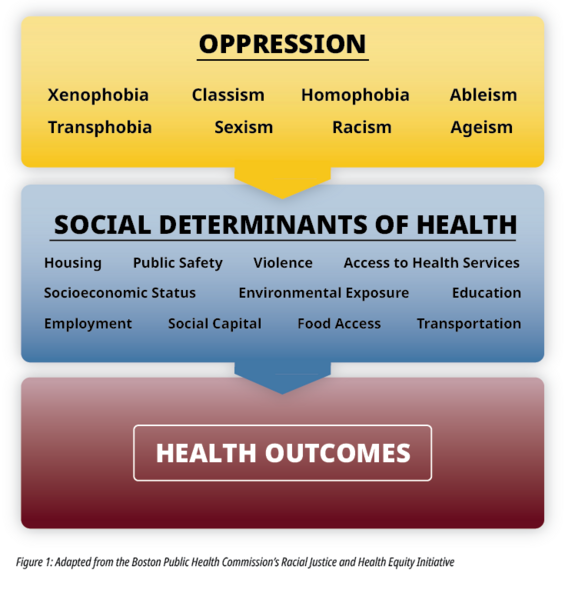About the Data
The number of Active WIC pregnant and postpartum adults, infants and children is calculated each month using the city/town of residence listed in the participant’s records, which may be different from the residence listed on the infant’s birth certificate. These monthly counts are then summed and averaged over the year to account for seasonal variation in active participation. WIC participants are not required to use the Local Program in their home neighborhood/town/city, but may receive services at any WIC site.

As you look at data on this webpage, you may see differences among population groups. The differences are especially noticeable between white people and people of color.
These differences exist because of structural racism. These differences are NOT because of an individual’s choices, behaviors, or identity.
Systems of oppression, such as racism, cause harm to everyone. They also influence the social determinants of health (SDoH), which impact health outcomes. See Figure 1.
It is important to keep these notes in mind when looking at the data and using it to inform public health efforts.
If you decide to share these data, remember to use racial equity context and framing. The DPH Racial Equity Data Road Map is one resource that can help.
About WIC Program Data
Calculation of the estimated WIC-eligible adults, infants and children:
Using annual birth certificate data from Massachusetts resident parents who delivered a live infant in-state, the approximate number of WIC-eligible adults and children in each city/town, based on the city/town of residence listed on the infant’s birth certificate, is estimated for the WIC Needs Assessment from the following:
- Infants—An infant born in a given calendar year was considered eligible either if the birthing parent indicated prenatal participation in WIC as recorded on the birth certificate, or if the birthing parent had their prenatal care or their labor and delivery paid for by government funds (predominately Medicaid). While not all Medicaid plans qualify for adjunctive eligibility, sensitivity analysis show approximately the same proportion of adults who participate in a Medicaid plan which does not qualify for WIC adjunctive eligibility equals the proportion of adults who qualify financially for WIC, but who have non-Medicaid insurance, making the indication of Medicaid payment on the birth certificate a suitable estimate of eligibility for the WIC Needs Assessment. If an infant’s birth certificate indicated birthing parent’s prenatal participation in WIC and Medicaid payment, the infant was still counted only once.
- Children—Eligible children were similarly identified using in-state resident birth certificate data for the four previous years prior to the given year for infants, minus infant deaths that occurred in those four previous years (i.e., if infants were born in 2018, data for children use 2014-2017 birth certificates).
- Adults—Eligible adults are estimated by the number of eligible infants (as calculated above) and the estimated maximum time an adult would be eligible for WIC services:
- Pregnant adults—Number of eligible infants x 0.667. This figure represents 8 out of 12 months of the year during which eligible adults could be pregnant, as very few adults enroll in WIC within 2 weeks of conception. This method allows for identification of pregnant adults who will deliver in the following year, but are eligible to participate in WIC during the given year. This method assumes that the number of births, and hence the number of pregnant adults, will be comparable between adjacent years. In 2018, there were 67,554 in-state resident births (based on preliminary data).
- Breastfeeding and postpartum (non-breastfeeding) adults—Number of eligible infants x 1.0. As a mainly-breastfeeding adult is eligible for WIC until their infant’s 1st birthday, theoretically as many adults remain eligible for the year as there are eligible infants. Postpartum (non-breastfeeding) adults remain eligible for 6 months after delivery, but are represented by the 12 month eligibility that a breastfeeding adult has, and therefore not counted separately.
- Total Number Eligible— The total number eligible is the sum of eligible infants, children, and adults, and is presented in PHIT.
As this method is different from the previous method, MA WIC does not recommend comparing these estimates of eligibility data to years prior to 2017. This method also utilizes the maximum length of time an adult is eligible for WIC based on significantly breastfeeding through her infant’s first year, which does not yet represent the infant feeding method of the majority of recent birthing parents. This method uses in-state resident live births (identified by MA birth certificate). Therefore, adults who live in MA during their pregnancies but who deliver outside of MA, and infants and children who are born outside of MA but who then move to MA, will not be counted. This method also does not capture eligible pregnant adults who miscarry or have a still-birth. Similarly, as we do not have a way to track migration, infants who are born in MA whose families then move out of state are not removed from the estimate. The estimated number of eligible adults, infants and children may be inflated because Military families are usually covered under TriCare insurance and are inadvertently included in the denominator of estimated WIC eligible adults, infants and children because of the government source of payment for prenatal care and labor/delivery. Military families which exceed the WIC financial guidelines are not eligible for WIC services.
Suppression —Towns with 1-9 eligible WIC participants have data suppressed to maintain participant confidentiality.
Smoking prevalence is for pregnant adults because while the overall prevalence among pregnant adults is similar to the overall prevalence among postpartum adults, there is a big difference in prevalence between breastfeeding and non-breastfeeding adults.
The WIC Nutrition Program keeps pregnant and breastfeeding adults and kids under 5 healthy.